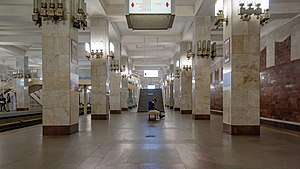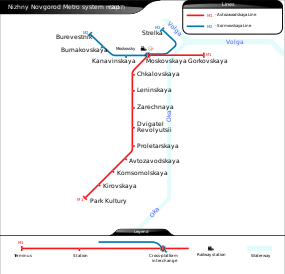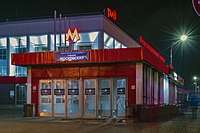Moskovskaya (Nizhny Novgorod Metro)
Moskovskaya (Russian: Московская) is a station on both Line 1 and Line 2 line of the Nizhny Novgorod Metro. It was one of the first six stations to open on the line on 20 November 1985.[1][2] It is also the only station that permits transfers from one line to the other. Passengers may also transfer to the main Nizhny Novgorod railway station. Also, the metro station Moskovskaya is a transfer hub to the station of the City Rail Nizhny Novgorod-Moskovsky.
| Nizhny Novgorod Metro station | ||||||||||||||||
 | ||||||||||||||||
| Location | Revolution Square | |||||||||||||||
| Coordinates | 56°19′17″N 43°56′43″E | |||||||||||||||
| Owned by | Nizhegorodskoe Metro | |||||||||||||||
| Line(s) | ||||||||||||||||
| Platforms | 2 | |||||||||||||||
| Tracks | 4 | |||||||||||||||
| Construction | ||||||||||||||||
| Structure type | Five-span, shallow column station | |||||||||||||||
| Parking | yes | |||||||||||||||
| Bicycle facilities | no | |||||||||||||||
| History | ||||||||||||||||
| Opened | 20 November 1985 | |||||||||||||||
| Services | ||||||||||||||||
| ||||||||||||||||

| | ||||||||||||||||||||||||||||||||||||||||||||||||||||||||||||||||||||||||||||||||||||||||||||||||||||||||||||||||||||||||||||||
|---|---|---|---|---|---|---|---|---|---|---|---|---|---|---|---|---|---|---|---|---|---|---|---|---|---|---|---|---|---|---|---|---|---|---|---|---|---|---|---|---|---|---|---|---|---|---|---|---|---|---|---|---|---|---|---|---|---|---|---|---|---|---|---|---|---|---|---|---|---|---|---|---|---|---|---|---|---|---|---|---|---|---|---|---|---|---|---|---|---|---|---|---|---|---|---|---|---|---|---|---|---|---|---|---|---|---|---|---|---|---|---|---|---|---|---|---|---|---|---|---|---|---|---|---|---|---|
| ||||||||||||||||||||||||||||||||||||||||||||||||||||||||||||||||||||||||||||||||||||||||||||||||||||||||||||||||||||||||||||||
| | ||||||||||||||||||||||||||||||||||||
|---|---|---|---|---|---|---|---|---|---|---|---|---|---|---|---|---|---|---|---|---|---|---|---|---|---|---|---|---|---|---|---|---|---|---|---|---|
| ||||||||||||||||||||||||||||||||||||
Until 2012, it was the northern terminus of the Avtozavodskaya line and, until the opening of Strelka station in 2018, it was the eastern terminus of the Sormovsko–Meshcherskaya line. Because the line curves westbound after Moskovskaya, it remains the easternmost station on the line.
It is in the Kanavinsky City District. The name comes from the Moskovsky railway station.
History
The construction of the station began in 1977. The Moskovskaya station was built in an open way, due to which many roads and the station square were blocked. The station was built immediately under the perspective two lines, was make it the largest in the Soviet Union and today's Russia.[3] In addition to the station itself, an extensive network of tunnels was built on the approach to it. Some of them connected the metro station with the Moskovsky railway station. The last such tunnel was built in 2018 and connected the station to the Central Department Store.
During the construction of the station, in 1984, the walls collapsed in its pit killing two workers from the student brigade. This accident served as the appearance of an “urban legend” about ghosts wandering through tunnels and stations.[4] Workers at the station told that they had heard strange sounds in the tunnels: groans, gnash of iron or the sound of jackhammers. However, people are skeptical and believe that extraneous sounds in tunnels are a consequence of the penetration and activity of “diggers”.[5]
The station was opened on November 20, 1985 as part of the first launch section of the Nizhny Novgorod Metro “Moskovskaya - Proletarskaya”.
From 1985 to 1993, she was the terminal station for the only Avtozavodskaya line. After the opening of the first section of the Sormovskaya line “Moskovskaya - Kanavinskaya”, it became final for her. A fork movement was organized at the station - trains of the Avtozavodskaya line “turned around” at the station and continued on their way along the Sormovskaya line. On November 4, 2012, after the opening of the Gorkovskaya station, it ceased to be the terminus for Avtozavodskaya line. And, after the opening of the Strelka station, June 12, 2018, the station has ceased to be terminus for both lines.[6]
Name
The metro station got its name because of the Moskovsky railway station and the Moscow highway. The project name is “Moskovsky vokzal”.
Entrances and interchanges
The station has two underground vestibules for ingress and egress of passengers. Exit from the south-west hall leads to a long underground passage to the Moskovsky railway station and to the Moscow highway. On both sides of the station are stairs and escalators. Since November 4, 2012, the station is located transfer bridge from Line 1 to Line 2. One of the entrances is located next to the Revolution Square. Another entrance to the station was built in the building of the Central Department Store.[7]
Nearby
- Moskovsky railway terminal
- The Metro Department
- Central Department Store
- Mebelny bazar Mall
- McDonald's
- Respublika Shopping сentre
- Gordeevsky Department Store
- Kanavinskiy Bus Station
- Minin University
- College of Railway Transport
- Chkalov Shopping centre
- The Central Bazaar
- Kanavinsky Shopping centre
Connection
Nizhny Novgorod City Rail
| # | Line | Route | Number of stations |
|---|---|---|---|
| 1 | Sormovskaya | Nizhny Novgorod railway station - Pochinki | 7 |
| 2 | Priokskaya | Nizhny Novgorod railway station - Prospekt Gagarina | 12 |
| Total: | 19 |
Gallery
 Entrance to the station near the train station
Entrance to the station near the train station Entrance to the station in the building of the Central Department Store
Entrance to the station in the building of the Central Department Store Panel above the descent to the platform
Panel above the descent to the platform Pointer to the platform
Pointer to the platform_(6584678649).jpg) Station name on track wall
Station name on track wall The train is on the central track. View from the bridge
The train is on the central track. View from the bridge The train is on the side track of the station. Sormovskaya line
The train is on the side track of the station. Sormovskaya line Train on the central station track. Avtozavodskaya line
Train on the central station track. Avtozavodskaya line
References
- "Из истории строительства Нижегородского метрополитена" (in Russian). State Archive of Nizhny Novgorod Oblast. Retrieved 2017-01-26.
- "Метрополитен в Нижнем Новгороде. Справка" (in Russian). RIA. 2010-11-19.
- "Метро в Нижнем Новгороде. История и строительство - Деловой квартал". nn.dk.ru (in Russian). Retrieved 2019-01-10.
- "10 фактов о нижегородском метро: фантомы погибших рабочих и станция-призрак". Блог о лучших местах Нижнего Новгорода и Нижегородской области (in Russian). 2017-04-03. Retrieved 2019-01-10.
- "В нижегородском метро наблюдали призрак рабочего". МирТесен - рекомендательная социальная сеть (in Russian). Archived from the original on 2019-01-10. Retrieved 2019-01-10.
- "History of the Nizhny Novgorod Metro". Nizhny Novgorod Metro. 2016-10-16. Retrieved 2019-01-10.
- "Underground crossing will be built between the metro station Moskovskaya and Central Department Store". opennov.ru (in Russian). Retrieved 2017-05-23.
The station opened on 20 November 1985, as part of the first starting area of the Nizhny Novgorod metro "Moskovskaya — Proletarskaya".